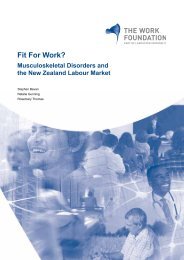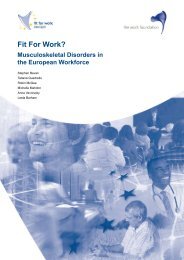FfW Bulgarian report (English language) - Fit for Work Europe
FfW Bulgarian report (English language) - Fit for Work Europe
FfW Bulgarian report (English language) - Fit for Work Europe
You also want an ePaper? Increase the reach of your titles
YUMPU automatically turns print PDFs into web optimized ePapers that Google loves.
Box 2. Case Study – EPIQ Electronic Assembly Ltd<br />
Interventions<br />
EPIQ is an electronics company with a presence in six <strong>Europe</strong>an countries as well as Mexico.<br />
It has production facilities in Bulgaria and manufactures electronic components <strong>for</strong> the car<br />
industry as well as <strong>for</strong> telecommunications, household, sanitary and medical equipment<br />
companies.<br />
The nature of the work is such that if gone unchecked, workers would be exposed to various<br />
processes and factors in the work environment that could damage their health and put them<br />
at risk of developing musculoskeletal disorders. For example, the production of components<br />
involves prolonged sitting or standing which can cause strain on the arms and legs. It may<br />
also involve movements that are repetitive. The work is also quite physically active, requiring<br />
co-ordination, accuracy and speed. In order to reduce the risks to which workers are exposed,<br />
the company have taken the following measures to create an environment that manages the<br />
health and safety of their workers:<br />
1) Health and safety training<br />
All workers receive health and safety training when they begin at the company. They<br />
are taught how to use the equipment safely and learn techniques to ensure it is used<br />
correctly. They also learn about potential hazards in the work environment and are<br />
taught how to prevent dangers and the importance of this. <strong>Work</strong>ers are educated about<br />
the impact of workplace factors on their health and are taught how to use tools and<br />
equipment to mitigate these factors, <strong>for</strong> example, by organising their work stations.<br />
2) Provide ergonomically designed work stations<br />
The work environment has been designed to prevent workers from working in damaging<br />
positions, or making any unnecessary movements, <strong>for</strong> example, by avoiding the need<br />
<strong>for</strong> them to twist or contort their backs. This has been done by providing workers with<br />
adjustable chairs and tables, encouraging good posture.<br />
3) Job design<br />
Jobs have been designed so that work has been reallocated and redistributed amongst<br />
workers in order to rotate tasks. This has decreased repetitive movements, strain on<br />
the hands and prolonged bending and twisting of the body. Rest periods have been<br />
installed which have reduced fatigue and improved sustained per<strong>for</strong>mance.<br />
4) Risk assessments<br />
Regular risk assessments are carried out of jobs and people at risk, with hazards<br />
being reduced or removed to control risk.<br />
Cont.<br />
<strong>Fit</strong> For <strong>Work</strong>? 57







